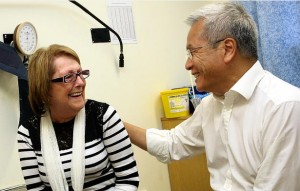 MedicalResearch.com Interview with:
Lao Saal, M.D. Ph.D.
MedicalResearch.com Interview with:
Lao Saal, M.D. Ph.D.
Head, Translational Oncogenomics Unit
Assistant Professor
Department of Oncology and Pathology
Lund University Cancer Center
Lund, Sweden
Medical Research: What is the background for this study?
Dr. Saal: About a quarter of women diagnosed with primary (non-metastatic) breast cancer will unfortunately progress and later be found to have metastatic spread, which can occur many years to even a decade or more after the first diagnosis. At this point, the prognosis after identification of metastatic breast cancer is very poor. Metastatic disease is typically diagnosed only after it has grown large enough to cause symptoms, be noticed on exam, or be detectable by imaging. It is thought that early detection of metastasis has the potential to lead to better outcomes because therapies could be modified when the metastasis is still very small. Moreover, a very sensitive and specific test that could identify patients who appear "cancer-free" could also be useful. Essentially all cancers have unstable genomes, where chromosomes physically break and are reassembled incorrectly and thus the normal sequence is altered. Importantly,
DNA material from cancer cells can be found in the blood circulation and therefore this circulating tumor DNA has the potential to be a cancer biomarker.
Medical Research: What are the main findings?
Dr. Saal: Eleonor Olsson, a PhD student in my lab who defends her thesis next week, and Christof Winter, a postdoc bioinformatician in my group, were the first authors of the paper. In our study we tested whether periodic monitoring of circulating tumor DNA (ctDNA) in blood plasma samples, taken before surgery for primary breast cancer and at multiple timepoints after surgery, could identify the metastastic spread, and whether the quantity of ctDNA was associated to patient outcome. We analyzed a retrospective cohort of 20 patients, who had enrolled many years ago in a separate epidemiological study run by Helena Jernström in our department, wherein the appropriate blood plasma samples had been biobanked and tumor tissue was available and we had long-term clinical follow-up information.
As far as we are aware, our study is the first to show the potential for serial ctDNA monitoring in the context of primary breast cancer. We found that our ctDNA blood tests could discriminate patients with eventual metastasis from those with long‐term disease‐free survival with 93% sensitivity and 100% specificity. Furthermore, ctDNA‐based detection of metastatic disease preceded clinical detection for 86% of patients by an average 11 months and in some cases by 3 years. In all of the patients who had long-term disease-free survival, we did not detect any ctDNA in any timepoints after surgery. Lastly, the measured quantity of ctDNA was a significant predictor of outcome: for each doubling of the ctDNA level, the odds ratio for metastasis was 2.1 and the odds ratio for death was 1.3. An interesting anecdote -- one patient we studied had bilateral
breast cancer and we found that it was the right-side tumor (which actually had more favorable clinical characteristics) that gave rise to the metastasis and not the left-side tumor.
(more…)
 MedicalResearch.com Interview with:
Dr. Alexandra White PhD in Epidemiology
University of North Carolina at Chapel Hill
Postdoctoral fellow
National Institute of Environmental Health Science
MedicalResearch: What is the background for this study?
Dr. White: Many studies have shown that being overweight or obese is a risk factor for postmenopausal breast cancer. We know less about how obesity impacts breast cancer risk in premenopausal women.
About a third of U.S. adults are obese, which is defined as having a body mass index (BMI) greater than 30. Similarly, the prevalence of abdominal obesity, measured by a person’s waist circumference, has increased by 10% in the last decade. In 2012, more than two-thirds of U.S. women had a waist circumference that indicated abdominal obesity.
Abdominal obesity may be a better predictor than BMI for breast cancer risk and other chronic diseases, because it is related to insulin resistance and can reflect metabolically active fat stores.
In order to understand how different types of obesity (overall vs. abdominal) influence breast cancer risk, we used information from >50,000 participants in the Sister Study. The Sister Study, led by scientists at the National Institute of Environmental Health Sciences, part of the National Institutes of Health investigates environmental and genetic risk factors for breast cancer.
(more…)
MedicalResearch.com Interview with:
Dr. Alexandra White PhD in Epidemiology
University of North Carolina at Chapel Hill
Postdoctoral fellow
National Institute of Environmental Health Science
MedicalResearch: What is the background for this study?
Dr. White: Many studies have shown that being overweight or obese is a risk factor for postmenopausal breast cancer. We know less about how obesity impacts breast cancer risk in premenopausal women.
About a third of U.S. adults are obese, which is defined as having a body mass index (BMI) greater than 30. Similarly, the prevalence of abdominal obesity, measured by a person’s waist circumference, has increased by 10% in the last decade. In 2012, more than two-thirds of U.S. women had a waist circumference that indicated abdominal obesity.
Abdominal obesity may be a better predictor than BMI for breast cancer risk and other chronic diseases, because it is related to insulin resistance and can reflect metabolically active fat stores.
In order to understand how different types of obesity (overall vs. abdominal) influence breast cancer risk, we used information from >50,000 participants in the Sister Study. The Sister Study, led by scientists at the National Institute of Environmental Health Sciences, part of the National Institutes of Health investigates environmental and genetic risk factors for breast cancer.
(more…)






















